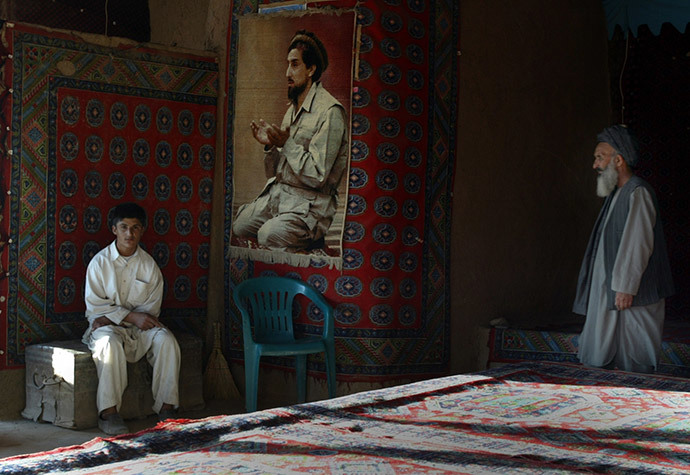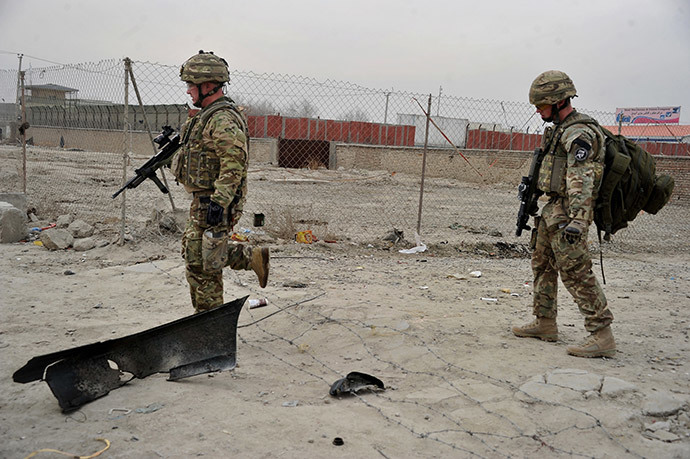Afghanistan: The USSR left, the US wants to stay

Just before noon on Feb. 16, 25 years ago, Lieut. Gen. Boris Gromov, top Soviet commander in Afghanistan, solemnly walked across the Friendship Bridge over the Amu Darya River into Uzbekistan. He uttered the words: “Our 9-year stay ends with this.”
The USSR was officially out of Afghanistan. It was a unilateral withdrawal – even as Daddy Bush, then US President, wanted to keep weaponizing those Afghan “freedom fighters” (copyright Ronald Reagan).
Rewind to the Soviet invasion, in December 1979. Few will remember how then US President Jimmy Carter – a hick Hamlet – almost burst into tears because the USSR had invaded that “profoundly religious” country.
Well, a few months earlier, the US ambassador in Afghanistan had been assassinated by those “profoundly religious” characters. And guess who tried to save him? The KGB. Dr. Zbig Brzezinski himself – the man who years later we would learn “invented” the USSR’s Vietnam, six months before the Soviet invasion – gleefully told the story to White House correspondents.
By the way, this all happened before the fall of the Shah of Iran, which sparked in the mind of Hamlet Carter the demented idea that the USSR was about to invade Iran and take over “our” Persian Gulf oil. The extremely cautious Soviet leadership would never even contemplate that notion.

It was the USSR, for instance, that had prevented the US from using nuclear weapons in Vietnam. And it was the USSR that prevented the US from intervening in Iran to save the Shah. The leadership in Moscow was very much aware that were the USSR to “invade” Iran to take over all that oil and gas, the US would launch no less than a nuclear war.
But to brandish the threat of a nuclear war after the Soviets entered Afghanistan was exactly what Carter did – something that frightened even the US establishment, as in George Kennan, the author of the “containment of communism” strategy. Wily Dr. Zbig, though, knew better; unlike pumpkin Carter, he wanted nothing else than the USSR to meet its Vietnam.
Let me hammer you towards progress
The USSR was helping Afghanistan since the aftermath of the October Revolution. The left had been very strong in the country since the 1950s. Then, in 1973, Mohammed Daoud led a coup against his cousin, King Zahir Shah. After the coup, communists and their allies kept playing an important role – even as they routinely cut each other’s throats.
In the middle of one of these very murky scraps the USSR decides to step in, privileging its favorite faction (led by Babrak Karmal) and, at least in theory, advancing the cause of socialism. Big mistake, with dizzyingly complex consequences – from the rise of jihadism to the fall of the Soviet Union itself, and up to Russian historians to evaluate.
The key problem was that both Daoud and Moscow tried to implement progress in Afghanistan with a hammer – with no effect. King Amanullah had tried as early as 1919, also supported by the Russians. It’s impossible to impose a progressive form of government onto peasants and warriors without changing a feudal structure perpetuated through millennia. Still after the Soviet exit, and now the tentative American exit, the problem remains.
We all know what happened after the Soviet withdrawal. The Afghan government remained in place as long as there was Soviet support. But then the USSR dissolved itself in December 1991. And collapse was followed by chaos, from 1992 to 1996. Every mujahid made a play for Kabul – from the “Lion of the Panjshir” Ahmad Shah Masoud to former Saudi favorite Gulbuddin Hekmatyar and former American favorite Abdul Haq.

Masoud is dead, killed by al-Qaeda two days before 9/11. Haq is dead, killed by the Taliban in November 2001 as the Americans were grooming him for a bright political future. Hekmatyar remains one of America’s top public enemies, but no more than a side player.
What finally emerged in 1996, when they captured Kabul, was the Taliban – a Pakistani invention. Gen. Zia ul-Haq, the ultra-fundamentalist general who ruled everything from 1977 to 1988, had “Islamicized” Pakistani society and especially the military-intelligence complex to a point of no return.
Then, during the 1980s anti-Soviet jihad, Pakistan controlled virtually every single mujahid via the Pakistani intelligence agency, the ISI. Those most lavishly weaponized were (what else?) hardcore Islamists; the CIA, partners in crime, were easily fooled. But Brzezinski, among others, knew what that would imply. He was fully aware of the American tradition of supporting every nasty bunch of medieval religious fanatics against nationalist and/or progressive movements in the then called Third World – and the myriad chances of blowback.
As Pakistan goes, for decades we have had an ISI continuum; support to the hardcore mujahideen in the 1980s; the Taliban in the 1990s; and since 9/11, more discreetly, the Afghan Taliban but not the Pakistani Taliban.
Today we also know that the US bombing and mini-invasion of late 2001, followed by NATO’s long occupation, was in fact devised even before 9/11, as the first Dubya administration got fed up with discussing Pipelineistan and Osama bin Laden with the Taliban and wanted to impose its own rules. 9/11 was the perfect pretext.
I vividly remember that even before Tora Bora, in late November 2001, Afghans of all stripes were convinced King Zahir Shah would return to the throne. Instead, they were presented with American puppet Hamid Karzai. Over the years, the American-led occupation fed on the rationale of “fighting al-Qaeda,” when in fact the whole operation turned into a white man’s war against Pashtuns, the overwhelming majority of them Taliban.
The ghost of Saigon 1975
Now the puppet has grown a set of balls; he won’t sign a Status of Force Agreement (SOFA) with the Americans. Washington’s quite predictable furious reaction is to finally ignore him and pray to clinch a deal with his successor.

Everyone knows the storm in the making. There’s absolutely no evidence a strong central government will emerge in Kabul after April’s elections. Not even minimally as strong as the Afghan government that survived for almost three years after the Soviet withdrawal 25 years ago.
There are the so-called “Afghan security forces” which totally depend on Western money and weapons. The Afghan government simply cannot afford them. Who will pay them? A consortium of Europeans, Russians and Chinese?
And then there’s the game Pakistan will play. Pakistan’s Afghan policy has always been “strategic depth,” as in controlling a weak Afghan state. This implies, in a nutshell, a “friendly” government; too weak in military terms to question the Durand line – the 2,500-kilometer artificial border “invented” by the British empire; and absolutely incapable of raising the intractable Pashtunistan issue, which is at the heart of the border controversy. Every each way we look at it, Islamabad sees Pashtun nationalism as an existential threat.
The Obama administration couldn’t care less – not to mention the Pentagon and the whole Beltway for that matter. The only thing that matters is to keep those prime real estate morsels in the Empire of Bases – especially Bagram, which Karzai defined as a “Taliban factory.” These military bases are essential to survey, harass or simply intimidate both Russia and China – thus key assets in the ever-evolving New Great Game in Eurasia.
The pretext used to be al-Qaeda. Al-Qaeda relocated to Libya and the Levant. The fight against the Taliban can’t qualify as a pretext anymore as Karzai himself is trying to clinch a deal with them, and NATO will be out of Afghanistan before the end of the year. As nasty as they can be the Taliban played, and keep playing, a very long game; they want to dictate the terms of post-American Afghanistan.
So what’s left to Washington after an interminable, multi-trillion-dollar war that ends with a monumental whimper - for all practical purposes a hardcore Pashtun victory? Not to abandon the battlefield entirely, as in Saigon 1975 (Gromov crossing the Friendship Bridge 25 years ago would pale in comparison). The solution is to leave a “residual” force of at least 10,000 that will keep enabling the CIA drone war in the Pakistani tribal areas, which will go on as long as Islamabad cannot clinch a deal with the Pakistani Taliban.
No powerful regional actors want this state of affairs, from Iran to Russia and China, not to mention the AfPak consortium. Throughout 2014, expect Iran, Russia, China and India to weigh heavily toward an Afghan solution without the Americans. Yet the “residual force” will remain the Pentagon’s wet dream. If they can't have Full Spectrum Dominance, even partial spectrum will do. That certainly beats crossing the Amu Darya back to Uzbekistan with a Saigon taste in their mouths.
The statements, views and opinions expressed in this column are solely those of the author and do not necessarily represent those of RT.
The statements, views and opinions expressed in this column are solely those of the author and do not necessarily represent those of RT.













